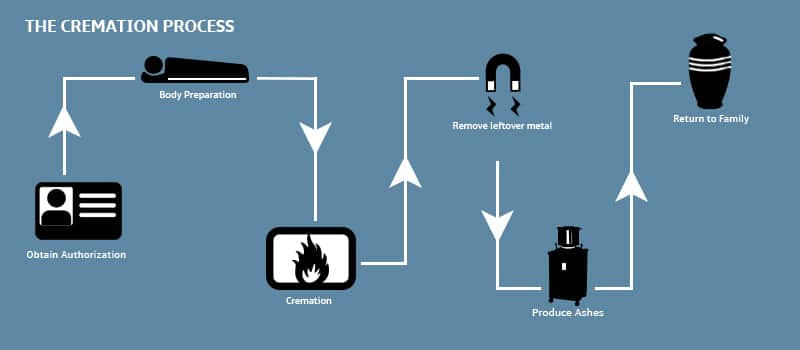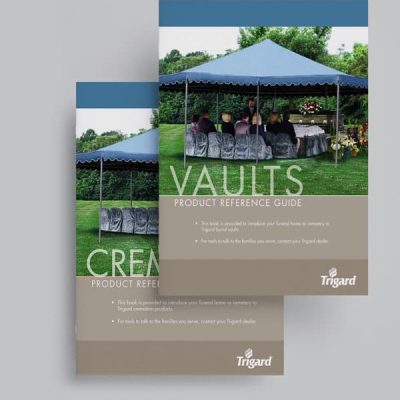Cremation has risen in popularity over the past twenty years. According to the Cremation Association of North America, in 2022, 59% of Americans chose cremation rather than traditional burial.
Cremation first surpassed burial as the internment option of choice in 2015. Since then, Americans’ preference for cremation has remained, and is predicted to rise to 65.2% by 2027.
There are several factors that have contributed to the rise in cremation including cost, looser ties to religious affiliations and family traditions, as well as environmental concerns.
Perhaps you’re planning ahead for your own final wishes or for those of a loved one. In either case, these are difficult and emotional decisions.
Understanding the cremation process and how cremation works can make those decisions easier.
What is Cremation?
Cremation is the process of breaking down human remains using intense heat and flame. This procedure takes place in a cremation chamber, also referred to as a retort.
In the United States, it is law that only one person can be cremated at a time.
What is the Cremation Process?
Most people have a basic understanding of cremation. They may still wonder, though, “How exactly does cremation work?”.
The cremation process involves the following steps:
- A funeral home or cremation service takes the deceased into their care and obtains authorization for cremation.
- Cremation technicians (often funeral directors) prepare the individual and place him or her in an appropriate cremation container or cremation casket.
- Technicians transfer the person into the cremation chamber, or retort.
- Next, the body is exposed to extreme heat and open flames for approximately 1.5 – 2 hours.
- Magnets then remove any leftover bits of metal (e.g. tooth fillings, medical plates).
- A special machine processes the remains and turns them into what we know as “ashes.”
- After cooling, the ashes are placed in a temporary container or urn and returned to the family.
The Cremation Process – Step by Step

| Stage | Details |
| Initial Steps | Funeral home or cremation service takes the deceased into their care and obtains authorization for cremation. |
| Preparing the Body | The body is washed, dressed, and prepared. Jewelry and personal effects are removed as per family’s wishes. Pacemakers, medical devices, and prosthetics are removed, while metal implants can remain. The body is placed in a temporary container and refrigerated until cremation. |
| Cremation Container | A sturdy, combustible container is used for the cremation process. Options range from simple cardboard boxes to cremation caskets resembling burial caskets, with minimal metal components. |
| The Cremation Chamber (Retort) | The retort is preheated and computerized, lined with fire-resistant bricks. The body in the container is exposed to flames, reducing it to bone fragments. A metal tray collects fragments for further processing. |
| Cremation Process | Intense heat (up to 1,800°F) vaporizes organic material, leaving bone fragments. Process takes 1.5 to 2 hours, varying based on body size and container type. Magnets remove metal bits (tooth fillings, medical plates). Remains are cooled and then processed into “ashes”. |
| Post-Cremation Handling | Bone fragments are pulverized into a fine powder. Metal remnants are removed and recycled. Ashes placed in a temporary urn or a provided urn by the family. |
| Additional Considerations | Embalming not required for cremation, but necessary for public viewing. Final identification of the deceased before cremation. A stainless steel ID disc follows the remains throughout the process. Cremation urns and vaults available for burial or home placement. Options for personalized memorials and keepsakes. Grief counseling and memorialization services offered by some providers. |
Cremation Process FAQs
The basic process of cremation is relatively straightforward. However, its importance and families’ unique needs and concerns may raise additional questions.
What Precautions Do Cremation Services Take to Protect the Integrity of the Body’s Identification?
Cremation services are regulated by state licensing boards. Industry recommendations also govern the identification process. These entities establish the procedures and regulations a cremation service must follow.
The Federal Trade Commission provides a comprehensive resource where you can learn more about the safeguards in your state.
In order to authorize the cremation, a family member or other appointed person must complete paperwork giving consent for cremation.
He or she will also indicate a person responsible for receiving the remains after cremation. If an urn has not already been selected, a temporary container may be required.
Depending on the crematorium, a family may be given the option to witness the cremation.
There are several precautions crematoriums take to ensure a family receives the remains of their loved one.
Typically, it is required for a loved one to positively identify the person who has passed away before the cremation takes place.
Cremation services also include a stainless-steel disc that has an ID# which follows the individual’s remains through the cremation process. When the family receives the cremated remains, the disc is included in the container.

Is Embalming Required for Cremation?
The cremation process itself does not require embalming. However, if a family chooses to have a public visitation before the cremation takes place, embalming is necessary.
Embalming sanitizes the loved one, making him or her more visually appealing, and delays decomposition so the person is suitable for viewing.
During embalming, fluids are removed and replaced with a solution of formaldehyde and other chemicals. Organs in the chest and abdomen are also drained of fluids and gases. They are then filled with a chemical preservative.
How is a Loved One Prepared for Cremation?
Prior to the final identification, the deceased’s body is typically bathed and dressed. Jewelry and other personal effects are removed according to the family’s wishes.
The cremation process also requires that mechanical devices and prosthetics be removed. Devices containing batteries can be especially problematic if they remain during cremation.
These devices can cause reactions when exposed to high temperatures in the retort.
Metal devices, like screws, pins, and artificial joints, can usually remain in place. These items can withstand the heat of the retort and are removed from the remains after the cremation is complete.
What Kind of Container is Used for Cremation?

The remains are to be contained in a sturdy, combustible container in order to be easily stored, lifted, and carried. The cremation container also serves as a safety barrier to protect the crematory operator.
Funeral homes generally offer a couple of different choices for cremation containers. Some families simply select a corrugated (cardboard) box.
Other families choose a cremation casket that has the appearance of a burial casket and is designed for the presentation of a loved one for a viewing or visitation.
Cremation caskets have a minimal amount of metal components making them suitable for cremation.
What Happens Inside the Retort?
When the deceased’s body is properly prepared, technicians preheat the cremation chamber. The retort is actually an industrial furnace that is computerized and lined with fire-resistant bricks.
The remains enter this chamber through a mechanized door. This mechanism operates quickly to ensure that little heat is lost.

Inside the chamber, the container holding the deceased is exposed to flames reducing the body to bone fragments which are the only organic materials capable of withstanding the heat of the retort.
A metal tray collects these fragments and other remaining materials for further processing.
How long does the cremation process take?
Usually, the process takes 1.5-2 hours, but the time can vary.
However, the time can vary depending on the person’s size and composition.
The type of cremation container and the efficiency of the furnace also affect cremation time.
How are the Remains Processed after Cremation?
When a person’s remains are removed from the retort, the mixture contains primarily bone fragments. If the body contained metal implants, screws, or dental work or if jewelry was not removed prior to cremation, these materials also remain.
After the cremation is complete, technicians allow the remains to cool. Then they examine the resulting mixture. They use forceps or magnets to remove any metal, which is usually recycled.
What Happens to the Cremated Remains Before they are Returned to the Family?
The final steps of the cremation process use a cremulator to reduce the bone fragments into a sand- or ash-like consistency. Cremated remains are usually whitish in color.
An average person produces between 3-7 pounds of cremated remains.
Cremation technicians usually transfer these remains to a plastic bag. If a family left an urn at the crematorium, technicians will place the bag in the urn.
For families that don’t provide an urn, the crematorium will return the ashes in a temporary container.
Beyond Cremation: Options for Honoring a Loved One
Once you choose cremation for yourself or a loved one, additional decisions such as determining a final resting place for the cremated remains need to be made. Many families select an urn to hold the cremated remains of their loved one.
If the cremated remains are to be buried, a cemetery may require an urn vault. Grave memorials can also be selected to further commemorate a loved one.
Bronze and Wood Urns
Urns are offered in several materials and styles and can be a special way to memorialize a loved one.
They can be kept in the home, buried in the ground, or placed in an above ground burial space called a cremation niche. Some of the most popular urns are made of bronze or wood.
Urns come in companion, full-size and keepsake sizes. Companion urns are designed to hold the cremated remains of two people.
Full-size urns hold the cremated remains of one individual, while keepsake urns hold a portion of the cremated remains.
Keepsake urns are often selected when a loved one’s cremated remains are to be divided among family members.
Urns are available to accommodate any budget and to fit in any surroundings. Styles range from classic to fully personalized with pictures, emblems, and text.
Cremation Urn Vaults
If a loved one’s cremated remains are to be buried, the urn will need protection after interment. Most urns cannot withstand the forces of the earth’s gravity or the weight of heavy equipment. Therefore, many cemeteries require an urn vault.
Burial vaults and cremation urn vaults offer this additional protection.
Trigard cremation urn vaults have multiple layers of protection including the thickest cover in the industry, a vacuum-formed polymer liner, reinforced concrete and a tongue-and-groove tape seal.
Like regular urns, cremation urn vaults are available in a range of options and can be personalized with special words of endearment and color photos.
Cremation Grave Markers
When the cremated remains are going to be buried, families may choose a personalized cremation memorial. Again, these can be customized with emblems and words of endearment.
Full-color photo medallions, collages with colored or oxide photos, and customized backgrounds are also available. Finally, like urns, cremation memorials include single and companion styles.
Make Final Decisions to Honor a Loved One
Determining if cremation is the best option can be highly personal and emotional.
Knowing the facts and understanding the cremation process as well as the options available can help you navigate those emotions and make a decision that leaves you and your family with peace of mind.
As you make these decisions, contact your local funeral home. A funeral director can help guide you to make these choices.
Resources
Industry Statistical Information – Cremation Association of North America (CANA)










